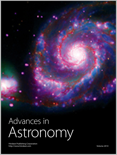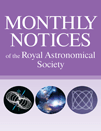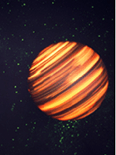
JOURNAL OF ASTROPHYSICS AND ASTRONOMY
Scope & Guideline
Fostering Innovation in Celestial Research.
Introduction
Aims and Scopes
- Stellar and Galactic Dynamics:
Research focusing on the dynamics of stars and galaxies, including studies on star formation, galactic structure, and the evolution of stellar populations. - Cosmology and Theoretical Astrophysics:
Explores the large-scale structure of the universe, dark matter, dark energy, and theoretical frameworks, including cosmological modeling and simulations. - Astrophysical Phenomena and Observations:
Investigates various astrophysical phenomena such as supernovae, black holes, and neutron stars through observational techniques in multiple wavelengths. - Exoplanetary Studies and Astrobiology:
Research related to the discovery and characterization of exoplanets, including their atmospheres, potential habitability, and the implications for astrobiology. - Astrophysical Instrumentation and Techniques:
Innovations in instrumentation and observational strategies that enhance the capabilities of telescopes and detectors for astronomical research. - High-Energy Astrophysics:
Studies involving high-energy phenomena such as gamma-ray bursts, X-ray binaries, and cosmic rays, focusing on the underlying physical processes.
Trending and Emerging
- Machine Learning and Data Science in Astronomy:
An increasing number of studies are utilizing machine learning techniques for data analysis, particularly in the identification of exoplanets and the classification of astronomical objects, highlighting the integration of computational methods into traditional astrophysics. - Astrobiology and Habitability Studies:
Research dedicated to understanding the conditions for life beyond Earth, including studies on exoplanet atmospheres and biosignatures, has surged, reflecting a growing interest in the potential for extraterrestrial life. - Multi-Messenger Astronomy:
The convergence of observations across various cosmic messengers, such as gravitational waves and high-energy neutrinos, is becoming a prominent theme, promoting interdisciplinary approaches to understanding astrophysical events. - High-Resolution Spectroscopy and Imaging:
There is a marked trend towards detailed spectral analysis and high-resolution imaging techniques, allowing for deeper insights into stellar and galactic phenomena. - Astrophysical Simulation Techniques:
Advancements in computational astrophysics and simulations of cosmic phenomena are increasingly prevalent, facilitating the exploration of complex systems and interactions in the universe.
Declining or Waning
- Traditional Stellar Astrophysics:
While research on stellar evolution remains significant, there has been a noticeable decrease in papers focusing solely on classical stellar models, as newer methods and technologies allow for more complex analyses. - Ground-based Observational Studies:
With the advent of space-based telescopes and advanced observational techniques, traditional ground-based studies are becoming less frequent, reflecting a shift towards more innovative and expansive observational methodologies. - Cosmological Constant Problem:
The discussions surrounding the cosmological constant and its implications have decreased, possibly due to advancements in understanding dark energy and the development of new theoretical models. - Classical Theories of Gravity:
Research focusing on Newtonian gravity and classical general relativity is declining as newer theories, such as modified gravity and quantum gravity approaches, gain traction among researchers.
Similar Journals

Journal of the Korean Astronomical Society
Advancing Astronomy: Unveiling the Universe's MysteriesWelcome to the Journal of the Korean Astronomical Society, an esteemed publication dedicated to advancing the fields of Astronomy and Astrophysics as well as Space and Planetary Science. Established in 1993 and under the reputable auspices of the Korean Astronomical Society, this journal serves as a vital platform for researchers and scholars from South Korea and around the globe to disseminate innovative findings and critical insights. With a commendable Q2 ranking in Astronomy and Astrophysics and a Q3 ranking in Space and Planetary Science, this journal is positioned among the influential voices in its fields, fostering collaboration and knowledge exchange. The journal's rigorous peer-review process ensures that published works contribute significantly to ongoing discussions and developments in astronomical research. While currently not an open-access journal, it remains accessible to the academic community, encouraging readers to stay abreast of the latest advancements in the sciences that elucidate the universe's complexities. Join us in exploring the cosmos through cutting-edge research and scholarly discussion that propels the field forward.

Advances in Astronomy
Exploring the Cosmos, One Discovery at a Time.Advances in Astronomy is a prestigious open-access journal published by HINDAWI LTD, dedicated to the field of astronomy and astrophysics. Established in 2008, the journal aims to disseminate significant research findings and advancements in the understanding of celestial phenomena, planetary sciences, and the intricate workings of the universe. With an impact factor that reflects its relevance in the scholarly community, Advances in Astronomy holds a commendable rank of Q3 in both Astronomy and Astrophysics as well as Space and Planetary Science categories, indicating its importance within these fields. The journal also showcases a commitment to open-access publishing, ensuring that research is readily available to both the scientific community and the public. Researchers, professionals, and students alike are encouraged to contribute to this dynamic forum to share knowledge and foster collaboration in exploring the wonders of the cosmos.

MONTHLY NOTICES OF THE ROYAL ASTRONOMICAL SOCIETY
Illuminating the Universe Through Rigorous Research.The MONTHLY NOTICES OF THE ROYAL ASTRONOMICAL SOCIETY (MNRAS), published by Oxford University Press, serves as a premier platform for the dissemination of significant research in the fields of Astronomy, Astrophysics, and Space and Planetary Science. Established in 1913 and with an impressive impact factor reflected in its 2023 Q1 rankings—13th in Earth and Planetary Sciences and 14th in Physics and Astronomy—this journal is renowned for its rigorous peer-reviewed articles, fostering advancements in our understanding of the universe. Researchers, professionals, and students alike benefit from its rich content, which spans a vast array of topics within its scope, from stellar dynamics to planetary formation. While the journal does not currently offer Open Access options, the scholarly contributions published herein are invaluable for pushing the boundaries of contemporary scientific inquiry and ensuring that the latest findings reach an engaged audience globally.

Annual Review of Astronomy and Astrophysics
Illuminating the universe through rigorous scholarship.Annual Review of Astronomy and Astrophysics is a premier academic journal published by Annual Reviews, dedicated to advancing knowledge in the fields of astronomy and astrophysics. With an impressive impact factor and recognition as a Q1 journal in both Astronomy and Astrophysics, as well as Space and Planetary Science, it stands amongst the top-ranked publications globally with Scopus Rankings placing it in the 99th percentile. The journal spans over three decades of scholarly contributions from 1990 to 2023, creating a rich repository of knowledge for researchers, professionals, and students alike. Although it does not offer Open Access, its rigorous peer-review process ensures the utmost quality and relevance of published articles, making it an essential resource for anyone seeking to stay at the forefront of developments in the cosmos. With its dedication to covering the forefront of research and essential reviews, the Annual Review of Astronomy and Astrophysics is vital for those engaged in exploring the universe and its phenomena.

Journal of High Energy Astrophysics
Exploring the Cosmos: Unraveling High-Energy MysteriesThe Journal of High Energy Astrophysics, published by Elsevier, is a premier platform for groundbreaking research in the fields of astrophysics and high-energy phenomena. With an ISSN of 2214-4048 and an E-ISSN of 2214-4056, this journal has quickly established itself as a leader since its inception in 2014. Operating out of the Netherlands, it is recognized for its rigorous peer-review process and high-quality publications, earning an impressive Q1 ranking across multiple domains, including Astronomy and Astrophysics, Nuclear and High Energy Physics, and Space and Planetary Science in 2023. With a Scopus rank of 12 out of 90 in the Astronomy and Astrophysics category, and being positioned in the 87th percentile, the journal plays a pivotal role in disseminating advancements and fostering collaboration among researchers, professionals, and students. Though the journal is not open access, it offers robust subscription options for institutions and individuals seeking to dive into the latest discoveries and theories in high-energy astrophysics.

Serbian Astronomical Journal
Advancing Astronomy Through Open Access ResearchSerbian Astronomical Journal, published by the Astronomical Observatory Belgrade, serves as a significant platform for research and innovation within the field of astronomy and astrophysics. With an established publication history since 1992 and an Open Access model, the journal ensures that its cutting-edge research is accessible to a global audience. The journal is recognized for its contribution to the scientific community, evidenced by its solid position in the 2023 Scopus category quartiles, ranking Q3 in Astronomy and Astrophysics. This positions it among notable journals in the discipline, despite being at the 18th percentile of its category rankings. Researchers, professionals, and students will find in Serbian Astronomical Journal a valuable resource for disseminating findings, exploring new discoveries, and engaging with contemporary challenges in astronomy. As the journal continues to evolve, it remains dedicated to advancing the knowledge and understanding of the universe.

Particles
Fostering Collaboration in Astrophysics and Nuclear Research.Particles is an esteemed open access journal published by MDPI, focusing on the dynamic fields of astronomy, astrophysics, and nuclear and high energy physics. Since its inception in 2019, the journal has made significant strides in contributing to scholarly discourse, achieving a commendable ranking in the Q2 category for its relevant fields as of 2023. With a commitment to disseminating high-quality research, it offers unrestricted access to a global audience, fostering collaboration and knowledge exchange among researchers, professionals, and students. Located in Basel, Switzerland, Particles serves as a platform for innovative research and discussions that leverage the latest advances in physics. Its current Scopus rankings underscore its impact and relevance, with notable positions in various categories within Physics and Astronomy. Through its rigorous peer-review process and diverse publication options, Particles continues to carve a niche in the academic landscape, catering to a growing community engaged in pioneering exploration of fundamental particles and cosmic phenomena.

ASTROPHYSICS
Connecting Stars: Bridging Research and Discovery in AstrophysicsASTROPHYSICS, published by Springer/Plenum Publishers, stands as a crucial platform for the dissemination of groundbreaking research in the field of Astronomy and Astrophysics. Established in 1965 and continuing its legacy until 2024, the journal highlights significant advancements, theoretical frameworks, and observational data that collectively push the boundaries of our understanding of the universe. Although currently categorized in the Q4 quartile for Astronomy and Astrophysics and holding a Scopus rank within the 17th percentile, ASTROPHYSICS remains dedicated to offering rigorous peer-reviewed content that is essential for researchers, professionals, and students alike. While it does not provide open access, the journal's accessibility through institutional subscriptions ensures a wide reach among the academic community, allowing it to address the rising curiosity surrounding cosmic phenomena and contribute meaningfully to ongoing scholarly discourse. For those seeking to engage with the latest findings and methodologies in astrophysics, ASTROPHYSICS continues to serve as an indispensable resource.

INTERNATIONAL JOURNAL OF MODERN PHYSICS D
Elevating Research Standards in Modern PhysicsWelcome to the INTERNATIONAL JOURNAL OF MODERN PHYSICS D, a premier publication dedicated to the advancement of knowledge in the fields of Astronomy and Astrophysics, Mathematical Physics, and Space and Planetary Science. Published by WORLD SCIENTIFIC PUBL CO PTE LTD in Singapore, the journal boasts an impressive impact, being ranked Q2 in Astronomy and Astrophysics and Mathematical Physics, and Q3 in Space and Planetary Science. With a converged publishing timeline from 1996 to 2024, this journal provides a vital platform for researchers and professionals to disseminate their findings, engage with cutting-edge research, and explore emerging ideas in modern physics. Although it operates under a traditional access model, the rigorous peer-reviewed process ensures that only the highest quality research contributes to the collective understanding of our universe. Join us in advancing the frontiers of physics and astronomy!

EXPERIMENTAL ASTRONOMY
Illuminating the Cosmos with Rigorous ResearchEXPERIMENTAL ASTRONOMY, published by Springer, stands as a pivotal journal in the fields of Astronomy and Astrophysics as well as Space and Planetary Science. With an impressive Scopus ranking and a Q2 category as of 2023, the journal is recognized for its impactful contributions to experimental techniques and observations in astronomy. Covering a broad spectrum of topics from cosmic phenomena to planetary exploration, it serves as a vital platform for researchers, professionals, and students to disseminate and discuss innovative ideas and findings. The journal has evolved through various convergence years since its inception in 1989 and continues to thrive, fostering an environment for academic pursuit and collaboration. Though not an open-access journal, its rigorous peer-review process ensures high-quality publications that are essential for advancing the scientific community's understanding of the universe.